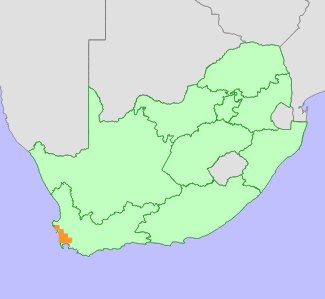|
Scientific Name | Lachenalia quadricolor Jacq. |
Higher Classification | Monocotyledons |
Family | HYACINTHACEAE |
Synonyms | Lachenalia aloides (L.f.) Engl. var. quadricolor (Jacq.) Engl., Lachenalia tricolor Thunb. var. quadricolor (Jacq.) Baker |
National Status |
Status and Criteria | Near Threatened B1ab(iii) |
Assessment Date | 2020/03/17 |
Assessor(s) | G.D. Duncan, H. Mtshali & L. von Staden |
Justification | Lachenalia quadricolor has a restricted distribution range, with an extent of occurrence (EOO) of 2333 km². It is declining across its range due to ongoing habitat degradation as well as competition from alien invasive plants, but recent field surveys indicate that it still persists at more than 10 locations, and therefore it nearly meets the criteria thresholds for Vulnerable under criterion B. |
Distribution |
Endemism | South African endemic |
Provincial distribution | Western Cape |
Range | This species is endemic to the coastal lowlands of the Western Cape, where it occurs from the West Coast near Langebaan southwards to the northern Cape Peninsula, Cape Flats and Somerset West. |
Habitat and Ecology |
Major system | Terrestrial |
Major habitats | Saldanha Granite Strandveld, Peninsula Shale Renosterveld, Swartland Granite Renosterveld, Peninsula Granite Fynbos, Boland Granite Fynbos |
Description | This species is always associated with granite outcrops, where it is localized to crevices or depressions in rock sheets, gravel sand or acid humus-rich matter. At a fruiting stage, the ripening fruits re-orientate themselves to a spreading or sub-erect position, then mature fruits split open and the seeds are dispersed locally by shaking action of wind. Flowers are pollinated by birds, and also visited by honey bees. |
Threats |
| This species has declined due to coastal development and urban expansion around Langebaan, Cape Town, Bellville, Brackenfell and Stellenbosch. Four known remaining subpopulations now occur in tiny urban parks, where they are threatened by ongoing habitat degradation due to encroaching alien invasive plants, inappropriate fire management and pollution.
In the Swartland and around Stellenbosch, most of the lowland granite fynbos and renosterveld has been converted to wheat fields and vineyards. This species' preference for shallow soils in rocky outcrops means that it was possibly spared significant habitat loss, but it has led to the isolation of subpopulations. Dense infestations of alien invasive plants are however outcompeting native species at four out of six recently observed locations in the Swartland around Darling and Mamre. |
Population |
Little is known about the local abundance of this species. Many subpopulations are isolated, occurring in small remnants of granite fynbos and renosterveld among suburbs, crop fields and vineyards, but since their sizes are unknown, it is not known whether the population is severely fragmented or not. Recent field surveys recorded this species at at least 12 locations, and it is possible that a few more exist at sites known through historical records where intact habitat remains. A continuing decline is inferred from ongoing habitat degradation and competition from alien invasive plants across most of its range.
|
Population trend | Decreasing |
Notes |
| L. quadricolor is similar to L. aloides. Both species have bright yellow to greenish-yellow outer and inner tepals. The latter differs in longer perianth tube and much longer outer tepals and the inner tepal have broad red or purplish red apices with white margins. Both species occur close in parts of its range but always occur in discrete populations, and also differs in habitat preference, with L. aloides preferring west-facing, decomposing granite slopes, and flowering several weeks earlier (Duncan, 2012). |
Assessment History |
Taxon assessed |
Status and Criteria |
Citation/Red List version | | Lachenalia aloides (L.f.) Engl. var. quadricolor (Jacq.) Engl. | Least Concern | Raimondo et al. (2009) | |
Bibliography |
Duncan, G.D. 2012. The genus Lachenalia. Kew Publishing, Royal Botanic Gardens, Kew.
Raimondo, D., von Staden, L., Foden, W., Victor, J.E., Helme, N.A., Turner, R.C., Kamundi, D.A. and Manyama, P.A. 2009. Red List of South African Plants. Strelitzia 25. South African National Biodiversity Institute, Pretoria.
|
Citation |
| Duncan, G.D., Mtshali, H. & von Staden, L. 2020. Lachenalia quadricolor Jacq. National Assessment: Red List of South African Plants version . Accessed on 2025/06/30 |
 Comment on this assessment
Comment on this assessment

